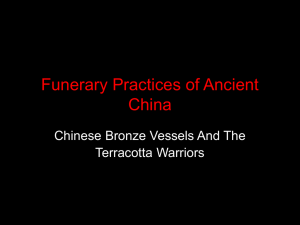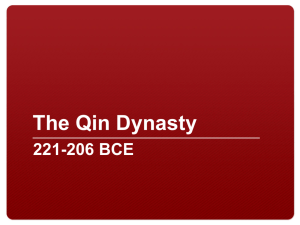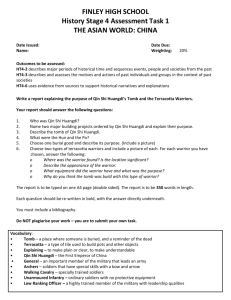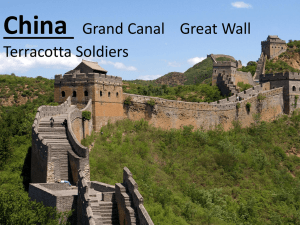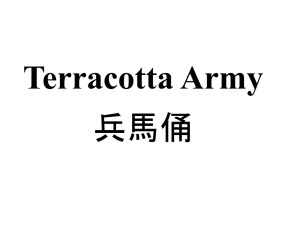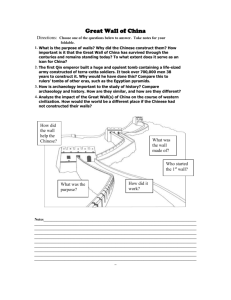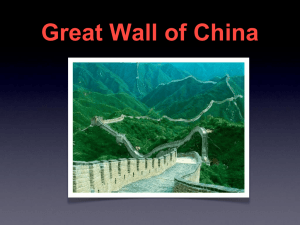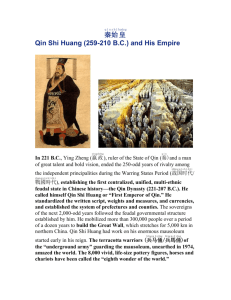Emperor Qin in the Afterlife
advertisement
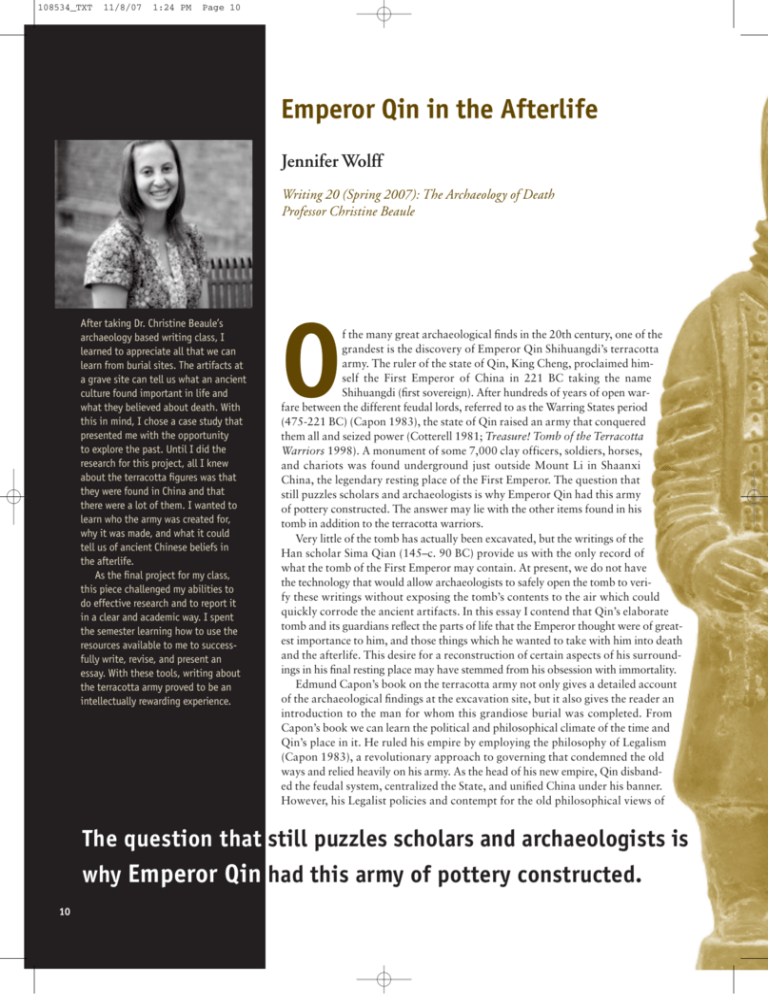
108534_TXT 11/8/07 1:24 PM Page 10 Emperor Qin in the Afterlife Jennifer Wolff Writing 20 (Spring 2007): The Archaeology of Death Professor Christine Beaule After taking Dr. Christine Beaule’s archaeology based writing class, I learned to appreciate all that we can learn from burial sites. The artifacts at a grave site can tell us what an ancient culture found important in life and what they believed about death. With this in mind, I chose a case study that presented me with the opportunity to explore the past. Until I did the research for this project, all I knew about the terracotta figures was that they were found in China and that there were a lot of them. I wanted to learn who the army was created for, why it was made, and what it could tell us of ancient Chinese beliefs in the afterlife. As the final project for my class, this piece challenged my abilities to do effective research and to report it in a clear and academic way. I spent the semester learning how to use the resources available to me to successfully write, revise, and present an essay. With these tools, writing about the terracotta army proved to be an intellectually rewarding experience. O f the many great archaeological finds in the 20th century, one of the grandest is the discovery of Emperor Qin Shihuangdi’s terracotta army. The ruler of the state of Qin, King Cheng, proclaimed himself the First Emperor of China in 221 BC taking the name Shihuangdi (first sovereign). After hundreds of years of open warfare between the different feudal lords, referred to as the Warring States period (475-221 BC) (Capon 1983), the state of Qin raised an army that conquered them all and seized power (Cotterell 1981; Treasure! Tomb of the Terracotta Warriors 1998). A monument of some 7,000 clay officers, soldiers, horses, and chariots was found underground just outside Mount Li in Shaanxi China, the legendary resting place of the First Emperor. The question that still puzzles scholars and archaeologists is why Emperor Qin had this army of pottery constructed. The answer may lie with the other items found in his tomb in addition to the terracotta warriors. Very little of the tomb has actually been excavated, but the writings of the Han scholar Sima Qian (145–c. 90 BC) provide us with the only record of what the tomb of the First Emperor may contain. At present, we do not have the technology that would allow archaeologists to safely open the tomb to verify these writings without exposing the tomb’s contents to the air which could quickly corrode the ancient artifacts. In this essay I contend that Qin’s elaborate tomb and its guardians reflect the parts of life that the Emperor thought were of greatest importance to him, and those things which he wanted to take with him into death and the afterlife. This desire for a reconstruction of certain aspects of his surroundings in his final resting place may have stemmed from his obsession with immortality. Edmund Capon’s book on the terracotta army not only gives a detailed account of the archaeological findings at the excavation site, but it also gives the reader an introduction to the man for whom this grandiose burial was completed. From Capon’s book we can learn the political and philosophical climate of the time and Qin’s place in it. He ruled his empire by employing the philosophy of Legalism (Capon 1983), a revolutionary approach to governing that condemned the old ways and relied heavily on his army. As the head of his new empire, Qin disbanded the feudal system, centralized the State, and unified China under his banner. However, his Legalist policies and contempt for the old philosophical views of The question that still puzzles scholars and archaeologists is why Emperor Qin had this army of pottery constructed. 10 108534_TXT 11/8/07 1:24 PM Page 11 Confucianism lead him to facilitate a book burning of all the old texts (Capon 1983). He also rounded up many of China’s leading philosophers and had them executed (Treasure! Tomb of the Terracotta Warriors 1998). Qin’s Legalist policy did not suit the newly unified Chinese nation the way it suited the earlier state of Qin in its quest for complete rule of China. Later Han scholars attributed the early downfall of the Qin Empire to this lack of policy change (Lewis 2007). Nevertheless, the First Emperor brought many changes to China. He standardized writing, language, measurements, currency, and trade (Treasure! Tomb of the Terracotta Warriors 1998). He also improved the roadways to make travel easier and commissioned the connecting and filling in of the disjointed sections of what would become the Great Wall of China (Kuwayama 1987). Despite the advances Qin made for China, he was a ruthless and tyrannical ruler. He delivered punishments of unparalleled cruelty to those who committed treason or any other crime. Qin’s harsh policies made him many enemies, especially among the feudal lords he had conquered, and at least three assassination attempts were made on his life (Cotterell 1981). These attempts on Qin’s life were responsible for his paranoia about death and his obsession with finding the route to immortality. Qin Shihuangdi also commissioned the building of hundreds of palaces both for himself and the lords upon whom he wanted to keep a close watch. From the day he took the throne in 221 BC, he began construction on his tomb and the terracotta army that would rest just outside of it in Shaanxi Province, just as the Egyptian pharaohs started construction on their tombs at the beginning of their reigns. Hundreds of artisans and thousands of convicted laborers from all of the various regions of China were brought to Qin’s capital city to work on his final resting place. The work on the tomb and the terracotta warriors is estimated to have spanned 38 to 39 years, and took a great toll on the Chinese population (Capon 1983). Just as Qin had control of everything around him, he would also have control of how he entered the afterlife and how he would pass his time in the next world. The discovery of the terracotta warriors outside Qin’s tomb was made by chance while a farmer was digging a well in Shaanxi Province in 1974. The entire archaeological site now covers 56.25 km 2 and includes four main pits and numerous satellite pits and burials. Three of the main pits contain both warriors and horses, but the fourth was left unfinished and empty by the original artisans. The excavation has shown that there were columns in the pits that Qin’s harsh policies made supported a roof and layers of earth that reached up to ground him many enemies, espelevel and the floors were paved with highly durable bricks cially among the feudal (Tianchou 1985). The warriors and pits are lords he had conquered, arranged in a fashion that suggests to scholars that they repre- and at least three assassisented the different sections of Qin’s real army. For example, Pit nation attempts were No. 1 is the largest of the pits. It contains an estimated 6,000 made on his life. These warriors, mainly infantrymen, and six chariots, each drawn by attempts on Qin’s life four horses (Capon 1983). Renbo Wang of the Shaanxi Provincial were responsible for his Museum suggests that the members of this pit represent the paranoia about death Right Army of the Imperial Guard. This section of the army and his obsession with would not have worn helmets (only Qin officers had those) finding the route to and always took the offensive. The lack of heavy armor on the immortality. Qin foot soldiers allowed them to attack quickly and with an unrivaled ferocity (Cotterell 1981). Pit No. 2 is smaller and “L” shaped, containing an estimated 1,000 clay soldiers, 400 horses, and 80 chariots (Tianchou 1985). Most of these soldiers were members of the cavalry, along with archers belonging to the Left Army of the Qin Imperial Guard. From the descriptions of the type of soldiers found in Pits 1 and 2 we see that the traditional Qin Right and Left armies are infantry and cavalry, respectively. The third pit is the smallest and in the shape of a “U”. It appears to be the command post, with 68 warriors, one chariot, and only four horses (Capon 1983; Tianchou 1985). The number of officers in this 11 108534_TXT 11/8/07 1:24 PM Page 12 From the day he took the throne in 221 BC, he began construction on his tomb and the terracotta army that would rest just outside of it in Shaanxi Province... There is, however, great debate over whether or not the soldiers were modeled on the actual members of Qin’s army, or if there were general patterns that the artists of the terracotta army followed. It was believed at this time that the soul was divided into two parts: one that would stay with the body, earthbound, and one that would ascend to heaven after death. The practice of human sacrifice played a big role in the funerary rituals for members of the elite in the time before Qin ascended to the throne. 12 Chinese mortuary rituals have been many and varied throughout history, yet there is little written about the beliefs and practices that surrounded death during the Warring States (481-221 BC) and Qin (221-206 BC) periods. It was believed at this time that the soul was divided into two parts: one that would stay with the body, earthbound, and one that would ascend to heaven after death. This belief accounts for attempts made to preserve the body after death (Brown 2002). It is certain, however, that there was a common belief in a life after death among the Chinese, and many death rituals were performed to ensure a good place in the afterlife. We know from arTable 1. Table Summarizing the terracotta army and how it relates to chaeological evidence that Qin’s real army (Capon 1983; Wang 1987). the practice of human sacrifice played a big role in Pit Number Type of Warrior Real Life Correlate the funerary rituals for Pit No. 1 Infantrymen, Charioteers Right Army members of the elite in the Infantrymen, Charioteers, Left Army Pit No. 2 time before Qin ascended Cavalrymen, Archers to the throne (Dien 1987). Albert E. Dien tells us Pit No. 3 Officers (1 Chariot with General’s Headquarters how the belief in the afCharioteers) terlife manifested itself in Pit No. 4 (empty) Central Army the tombs, grave goods, and N/A Stable master, stable boys Imperial Stables sometimes human skeletons that accompanied the unclear what types of soldiers made up this sec- dead into the next world. He also mentions tion of the Imperial Guard. Table 1 summarizes that the practice of human sacrifice was on the decline by the time of the unification of the contents of the terracotta army. Instead of all of the soldiers being created China, and figures or statues were increasingly from one model, each warrior is individual- used as substitutes for actual human victims ized (see Figure 1). Although there appears to (Dien 1987). With this knowledge we might be tempted be a number of basic head shapes for the warriors, their expressions vary, showing happi- to say that Qin’s terracotta warriors were ness, concentration, anger, and many other meant to represent the army that otherwise emotions (Capon 1983; Tianchou 1985). There would have been sacrificed when Qin died. This is, however, great debate over whether or not may be a convincing explanation for the crethe soldiers were modeled on the actual mem- ation of the terracotta army when we take into bers of Qin’s army, or if there were general pat- account the meaning of mingqi, or “spirit vesterns that the artists of the terracotta army fol- sels,” which were substitutes for real objects, lowed (Kresner 1995). The armor and clothing such as people, that could not be placed in the of the warriors are carefully recreated with grave (Kresner 1995). However, Kresner argues folds or individual plates of armor and are dif- that the clay figures that comprise the army are ferent depending on the particular post of the not modeled after individual people, which supports her claim that the army was not made warrior in the overall army. Additionally, every soldier and horse was with the intention of being mingqi (Kresner originally painted with plant pigments that 1995). Given that the clay figures, in this case, have worn away with time. The army was al- represent an army of thousands, it is not feasiso equipped with high quality real bronze ble that the entire army would be sacrificed to weapons that had been chrome plated to pre- appease the Emperor. Additionally the real warserve the sharpness of the weapons (Capon riors would have had to stay behind to help 1983; Treasure! Tomb of the Terracotta Warriors guard and control the empire. Without its 1998). The precision of the weapons again famous army, the dynasty that Qin Shihuangdi adds a level of reality to the pottery army. started to build would be left vulnerable, and pit and its well protected position in the northwest corner of the overall formation (Capon 1983, pp. 41), with the two larger parts of the army in front of it, suggest this was indeed the general’s headquarters. Additionally, some of the weapons recovered from this pit were meant more for ceremonial use than practical use in battle (Cotterell 1981). Altogether it seems that command over the entire 7,000 man army was to rest with the general or high commander, who is missing from the third pit. Finally, Wang (1987) hypothesizes that the fourth and uncompleted pit may have been intended for the Central Army; however it is 108534_TXT 11/8/07 1:24 PM Page 13 Figure 1. Only part of the vast burial complex in Shaanxi Province has been uncovered (photo by Alan Crawford). Qin’s descendants would not have been able to keep order. Thus it seems that the real army was never meant to be sacrificed; therefore the terracotta replica must have served some other purpose than that of mingqi. Qin Shihuangdi was known for his vast army and for commanding it with ruthless efficiency. His army was certainly an important tool not only in overcoming the many warring feudal lords, but also for keeping order among his new subjects and enforcing his Legalist views. Based on how much the Emperor relied on his army, it is logical to assume that his army was among his highest priorities. We also expect to see other recreations of things that were important to Qin in his tomb. For example we might expect to see some of his larger building projects replicated in his tomb, such as palaces or the Great Wall. There would also be items that showed his wealth and stature such as precious stones or expensive artwork. All of these elements contribute to the recreation of Qin’s true life in the afterlife and allow him to achieve immortality by being able to experience a continuation of the same life in the next world. The Shi Ji (Records of the Grand Historian) by Sima Qian (Capon 1983; Thorp 1987) provides evidence that Qin’s tomb reflects his fixation with immortality. This document tells us what actually rests in the tomb with the Emperor’s body. Although Qian’s account of what is in the tomb may not yet be verified by visual evidence, the fact that the remarkable terracotta army was not just legend lends some credence to what Qian claims. If we hypothesize that Emperor Qin had his elaborate burial constructed so that he would have his priorities reflected in the afterlife, we expect to see that Qin’s army was invaluable to him in life and that its terracotta replica should be reconstructed with a great deal of accuracy to properly represent its living counterpart. Qin’s military conquest of China made his army and its war horses an essential part of the Qin Empire. The number of horses and chariots that have been found in the excavations lets us know the strength of Qin’s army — that is, if we accept the argument that the terracotta army truly does represent Qin’s living army. Fu Tianchou says that “war chariots and horses 13 108534_TXT 11/8/07 1:24 PM Page 14 were the principal criterion for measuring the military strength of a kingdom and constituted the main heavy weaponry of an army” (Tianchou 1985, pp. 89). The ability to fight from horseback or from horse-drawn chariot was an improvement over fighting on foot and showed a development in the evolution of war. The upkeep of so many horses, which were just as valuable to the army as the human beings, had to be organized. Just as in real life there are stable masters to take care of such matters, terracotta figures were found in a satellite pit that were to carry out this same task in the afterlife (Wang 1987). A group of pits found to the east of Mount Li contained the stables for the army’s war horses (Wang 1987), which only adds to the sense that the arrangement of terracotta warriors mirrored the real formation and components of the Imperial Guard. These pits had more pottery figures which represented the stable masters and the stable boys (Wang 1987). All of this careful attention to detail concerning the location of the different parts of the army, and the detail in their clothing and the superiority of their weapons, supports the claim that these figures accurately represented Qin’s real army. The high degree of variation in the facial features of the warriors also contributes to this effect. Even if the warriors were not modeled on real people, as Kresner (1995) claims, there is a greater sense of reality created by the differing visages on the clay soldiers than if they were all identical. Again this sense of reality leads us back to the idea of immortality. By having a guardian army for his tomb that is so life-like, down to the stable workers that attend to the horses, Qin is increasing the length of his “life” by bringing those things that he thought most important with him to the next world. If Qin wanted such an exact replication of his army outside of his tomb, it is reasonable to say that he probably wanted equal reality within his tomb where his body would actually be. Not only would the opulence of the Emperor’s life follow him to the grave in the form of jewels and other expensive furnishings, the Chinese historian Sima Qian tells us what else accompanied the emperor into death (Capon 1983, pp. 24): They dug through three subterranean streams and poured molten copper for the outer coffin, and the tomb was fitted with models of palaces, pavilions and offices, as well as fine vessels, precious stones and rarities. Artisans were ordered to fix up crossbows so that any thief breaking in would be shot. All the country’s streams, the Yellow River and the Yangtze were reproduced in Tests on the soil near and under Mount Li have shown unusually high concentrations of mercury. 14 108534_TXT 11/8/07 1:24 PM Page 15 quicksilver and by some mechanical means made to flow into a miniature ocean. The heavenly constellations were shown above and the regions of the earth below. This account may seem unrealistic, but there may in fact be some truth in it. Tests on the soil near and under Mount Li have shown unusually high concentrations of mercury (Kresner 1995; Thorp 1987; Treasure! Tomb of the Terracotta Warriors 1998) which lends support to Qian’s historical account. We also know from the Shi Ji that the emperor had hundreds of palaces built, including the Apang Palace with “terraces that could seat ten thousand” (Capon 1983). It is very likely that the models of palaces that were brought into Qin’s tomb were scale models of not just his own palace but all those that he had ordered built. The fact that these were just models of palaces and not life-size palaces tells us that even though he liked to have numerous lavish palaces, they were not as important to him as his army, which was recreated as life-size soldiers and horses. However, with the number of palaces he had built the only way to replicate more than one or two of them inside his tomb may have been as smaller models. That does not mean that the models were built with any less detail and opulence of material than either the true palaces or the terracotta warriors. What the description of Qin’s tomb above tells us is that he wanted to take his empire with him so that he would have something to rule over in the afterlife. It is important to note that in ancient China it was believed that you continued on into the afterlife as you were when you died, especially where social and political status were concerned (Treasure! Tomb of the Terracotta Warriors 1998). The higher status you had in life, the closer to Shang Di (the Lord on High) you would be in the next world (Dien 1987). This point makes the imitation of reality very important for the afterlife. Having a complete representation of his empire and the things he commanded, including his army, allowed Qin to enter the afterlife with a clearly defined status that could not be challenged. After comparing the pottery army to Qin’s actual warriors, it seems that it is indeed a realistic representation of Qin’s true army. The same logic that we apply to the army can be applied to Qin’s actual tomb, albeit with slightly less confidence because we have no visual confirmation of what is claimed to be in the tomb. To all appearances Qin Shihuangdi desired to have those things on which he placed high priority with him in death. Further proof that this was indeed the intent for the terracotta warriors lies with archaeological evidence from periods preceding the Qin Dynasty and from other parts of the country. Kresner (1995, pp. 116) writes that: The goal of tomb builders was to represent all aspects of this world in the netherworld, to produce within a tomb a comprehensive replica of the human world. Therefore, the artificial substitutes were regarded as even more appropriate, more fitting for this task than the interment of real people, as they would be able to depict all the required activities — embodied in specific postures and gestures — far better than sacrificial victims could. Along the same lines, the contents of the actual tomb were not merely grand works of art showing the luxury of Qin’s world but they were representations of real things. Kresner quotes from Wu Hung, “In the Lishan tomb, however, art imitated actual things: there was an artificial ocean and flowing rivers, and all images were arranged to create an artificial microcosm of the universe” (Hung 1988, pp. 94, as cited in Kresner 1995, pp. 129). In addition to facilitating Qin’s ease in transitioning into the afterlife and ensuring him good status with Shang Di, the riches and grandeur of the tomb help to secure authority for what he believed would be future generations of Qin rulers. The splendor of one Emperor’s resting place was a symbol of wealth and status and helped to back the authority of the new Emperor. That is to say, Qin foresaw himself as the start of a new ruling dynasty in Chinese history and he was securing the right of inheritance for his descendents. The fact that the Qin Dynasty did not last does not detract from what Qin Shihuangdi’s tomb was intended to do. By having his army painstakingly recreated and models of palaces placed in his tomb, Qin may still have been trying to achieve immortality. During his life Qin had tried several ways to find the answer to eternal life: he drank elixirs of jade and mercury, he climbed mountains (the legendary resting places of the gods), and he even sent hundreds of children out onto the sea to search for the rumored islands inhabited by wise men who supposedly knew the secret to immortality (Capon 1983; Treasure! Tomb of the Terracotta Warriors 1998). By having all the trappings of his life transferred to what life he may experience beyond death is, in a way, living the same life eternally. Having a complete representation of his empire and the things he commanded, including his army, allowed Qin to enter the afterlife with a clearly defined status that could not be challenged. During his life Qin had tried several ways to find the answer to eternal life: he drank elixirs of jade and mercury, he climbed mountains (the legendary resting places of the gods), and he even sent hundreds of children out onto the sea to search for the rumored islands inhabited by wise men who supposedly knew the secret to immortality. 15 108534_TXT 11/8/07 1:24 PM Page 16 However, it is puzzling why someone so focused on staying alive as long as possible would have such lavish and detailed plans in place for his tomb. Granted, the work on any emperor’s tomb started as soon as he ascended to the throne, but none did so on such a large or lavish scale. One possible explanation for the grandness of Qin’s project is as stated above; he was still searching for the path to everlasting life, even in death. One way to further build on this argument would be to see if the Great Wall was put on the map of the empire in Qin’s tomb, despite its not being mentioned by Qian. Although the tomb at Mount Li has not been opened and we do not truly know what is in it, we might hypothesize that the Great Wall would be part of the reality transferred into the tomb, since this was one of Qin’s biggest and most famous projects. He had the Wall built in order to protect his country, which he highly valued, so perhaps he would have the Great Wall recreated in his tomb to protect his empire in the afterlife. Emperor Qin Shihuangdi, First Emperor of China, wanted the comforts and valued aspects of his life to follow him into death so that he could at last achieve immortality. ª Works Cited Brown, Miranda (2002). “Did the early Chinese preserve corpses? A reconsideration of elite conceptions of death.” Journal of East Asian Archaeology 4(1-4): 201-223. Capon, Edmund (1983). Qin Shihuang: Terracotta Warriors and Horses, 3rd edition. Clayton, Victoria, Australia: Wilke and Company Limited. Cotterell, Arthur (1981). The First Emperor of China. New York: Holt, Rinehart and Winston. 16 Dien, Albert E. (1987). “Chinese beliefs in the afterworld” in The Quest for Eternity: Chinese Ceramic Sculptures from the People’s Republic of China, pp. 1-15, edited by Susan L. Caroselli. San Francisco: Los Angeles County Museum of Art Chronicle Books. Fu, Tianchou (1989). Wonders from the Earth: The First Emperor's Underground Army, Rev. Edition. San Francisco: China Books and Periodicals. Hung, Wu (1988). “From temple to tomb: Ancient Chinese art and religion in transition.” Early China, 13: 78-115. Keightley, David N. (1991). “The quest for eternity in ancient China: The dead, their gifts, their names” in Ancient Mortuary Traditions of China: Papers on Chinese Ceramic Funerary Sculptures, pp.12-24, edited by George Kuwayama. Los Angeles, CA: Los Angeles County Museum of Art. Kresner, Ladislav (1995). “Likeness of no one: (Re)presenting the first emperor’s army.” The Art Bulletin 77(1): 115-132 Lewis, Mark E (2007). The Early Chinese Empires: Qin and Han. Cambridge: The Belknap Press of Harvard University Press. Thorp, Robert L. (1987). “The Qin and Han imperial tombs and the development of mortuary architecture” in The Quest for Eternity: Chinese Ceramic Sculptures from the People’s Republic of China, pp. 17-37, edited by Susan L. Caroselli. San Francisco: Los Angeles County Museum of Art Chronicle Books. Treasure! Tomb of the Terracotta Warriors. A&E Home Video, 1998. Wang, Renbo (1987). “General comments on Chinese funerary sculpture” in The Quest for Eternity: Chinese Ceramic Sculptures from the People’s Republic of China, pp. 39-61, edited by Susan L. Caroselli. San Francisco: Los Angeles County Museum of Art Chronicle Books.
